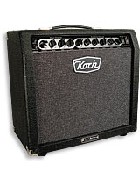
The Twintone is the Netherlands-based Koch Guitar Electronics company’s mid-sized guitar amp, a 1×12″ combo that, like the entire Koch line, uses top-quality components including cold-lacquered transformers, fiberglas-reinforced PC boards, and heavy duty potentiometers.
The Twintone’s all-tube circuit features a matched pair of Ruby EL34s housed in a punched-steel cage (to protect against breakage from loose footswitches or other items that may end up floating around in the back of the amp). The preamp section uses four 12AX7s protected with steel retainer strips. Its 11-ply birch plywood cabinet is covered in thick, black tolex and features cabinet-grade plywood bracing and back panels.
The Twintone’s 12″ speaker is a custom-designed ceramic-magnet Jensen VG12-90 rear-mounted on a presswood baffle. The brushed-aluminum control panel features large, black silkscreen with large knobs that complement the black/silver grillecloth and are easy to read on a dark stage. The overall quality look and vibe of the amp is traditional but still unique enough that you could pick it out of a crowd easily. Front panel controls include volume, bass, mid, and treble for the clean channel; and gain, volume, presence, bass, mid, and treble for the overdrive channel, as well as the power/standby switches and normal/bright clean-input jacks. The second input jack is voiced for guitars with humbucking pickups; it removes some mids and pads the signal slightly. The rear-panel controls consist of a channel switch for going from clean to overdrive channels (if you’re not using the footswitch), a reverb-level knob, series effects loop jacks, record out jack, headphone jack, and rhythm/solo level control. The rhythm/solo control can be pre-set and accessed via the two button footswitch, giving you, in essence, four presets – two for the clean channel and two for the overdrive channel.
To check out the Twintone’s twin tones (clean and overdrive) we used a Fender Custom Shop Robert Cray Stratocaster, a dual-humbucker Fender Flame, and a Gretsch 6120 Brian Setzer with FilterTrons.
First up was the Cray Strat through the clean channel, which produced a pristine, full, clean tone with tight low-end – the type you might expect from a 2×12″, not necessarily a 1×12″. The amp allowed the Strat’s crisp, bell-like tone and punchy low-end to go on full display, without getting thin or farting out.
Next, we dialed in a bit of reverb from the somewhat inconveniently-placed rear-mounted knob (without leaning over the amp, it’s difficult to tell where the control is set). But the result is more than worth the inconvenience; the Twintone’s reverb is outstanding, with a lush, smooth, swell and ultra-wet tone. Even dialed in heavy, it never gets in the way or loses definition. This is killer surf tone! The large Accutronics reverb tank and well-voiced reverb circuit make the reverb a standout feature, not just the usual add-on.
The other “tone” of the Twintone – the overdrive channel – also sounded very good with the Strat, much more versatile than the Koch Classictone we tested in the January ’04 issue. We easily dialed in a thick-but-moderate bluesy overdrive like the Classictone, but we also found a thicker, high-gain, crunchy, rock distortion with ample amounts of overdrive and no buzzy high-end. With the Fender Flame’s bridge pickup in the overdrive channel, and the gain and volume pushed fairly hard, we got a solid tone that stayed together without washing away the low-end or mushing up high-end, and all at a gig-capable volume.
The Twintone can be cut to 25 watts of output using its built-in power soak (or the recording-out with speaker simulation.) without sacrificing tone. With humbuckers or FilterTrons through the second bright/clean input, the amp’s clean tone was bright, but stayed smooth without the honky midrange and floppy low-end you can get from humbuckers in this mode. This allowed us to switch guitars without having to mess with the tone controls in the clean channel. The filter on the bright/clean input is bypassed in the overdrive channel, so you don’t have to switch back to the other input for optimum overdrive tone.
The tone controls on both channels are subtle, but very useful, and allow the user to adjust the tone of the amp for each guitar without losing the natural characteristics of the guitar’s tone.
At 193/4″ x 181/2″ x 101/2″, the Koch Twintone may be small, physically. But it is huge in terms of features and tone. An amp that truly has both a solid clean and overdrive sound, and outstanding reverb.
Koch TwinTone 50
Features All-tube circuits, matched Ruby EL34 power tubes, built-in power soak, Accutronics reverb tank, 11-ply birch plywood cabinet, two-button footswitch, independent clean and overdrive channels, independently voiced inputs for single-coil and humbucker pickups, rhythm/solo boost circuit.
Price $2,150
Contact Audionova Inc. , Dorval, Quebec, H9P 1H3, Canada; phone (514) 631-5787 ext. 22; audionova.ca
This article originally appeared in VG‘s April ’05 issue. All copyrights are by the author and Vintage Guitar magazine. Unauthorized replication or use is strictly prohibited.



